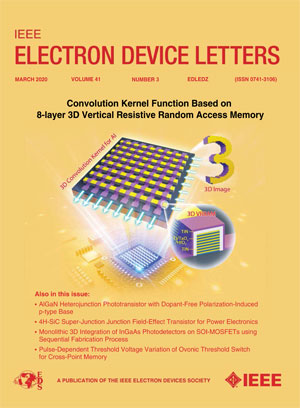A Novel Quadruple Corrugated Waveguide Slow-Wave Structure for Terahertz Applications
IF 4.1
2区 工程技术
Q2 ENGINEERING, ELECTRICAL & ELECTRONIC
引用次数: 0
Abstract
A novel quadruple corrugated waveguide slow-wave structure for terahertz radiation sources has been proposed, designed for pencil and sheet electron beams. It is compared in detail with a double corrugated waveguide slow-wave structure in terms of dispersion, interaction impedance, and output power. High-frequency characteristics show an interaction impedance of用于太赫兹应用的新型四重波纹波导慢波结构
我们提出了一种用于太赫兹辐射源的新型四波纹波导慢波结构,该结构专为铅笔电子束和片状电子束而设计。该结构与双波纹波导慢波结构在色散、相互作用阻抗和输出功率方面进行了详细比较。高频特性显示,在 0.34 太赫兹时,四波纹波导片状电子束隧道的相互作用阻抗为 0.77~\Omega $,四波纹波导铅笔电子束隧道的相互作用阻抗为 0.55~\Omega $,双波纹波导的相互作用阻抗为 0.5~\Omega $。为了验证所提出的慢波结构,我们设计了一个 0.34 THz 的后向波振荡器,片状电子束可产生 6.3 W 的峰值功率,频率可调范围为 0.281-0.368 THz,铅笔电子束可产生 2.6 W 的峰值功率,频率可调范围为 0.286-0.365 THz。基于双波纹波导的 BWO 的输出功率为 2.2 W。冷测试实验表明,在 0.34 THz 时,{S}_{21}}$ 超过 -2 dB,{S}_{11}}$ 低于 -16 dB。
本文章由计算机程序翻译,如有差异,请以英文原文为准。
求助全文
约1分钟内获得全文
求助全文
来源期刊

IEEE Electron Device Letters
工程技术-工程:电子与电气
CiteScore
8.20
自引率
10.20%
发文量
551
审稿时长
1.4 months
期刊介绍:
IEEE Electron Device Letters publishes original and significant contributions relating to the theory, modeling, design, performance and reliability of electron and ion integrated circuit devices and interconnects, involving insulators, metals, organic materials, micro-plasmas, semiconductors, quantum-effect structures, vacuum devices, and emerging materials with applications in bioelectronics, biomedical electronics, computation, communications, displays, microelectromechanics, imaging, micro-actuators, nanoelectronics, optoelectronics, photovoltaics, power ICs and micro-sensors.
 求助内容:
求助内容: 应助结果提醒方式:
应助结果提醒方式:


